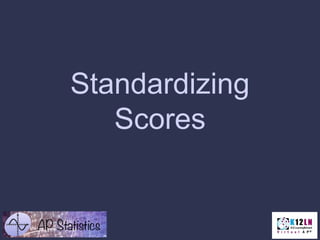Denunciar
Compartilhar
Baixar para ler offline

Mais conteúdo relacionado
Mais de Ulster BOCES
Mais de Ulster BOCES (20)
Standardizing scores
- 2. Z-score • # of standard deviations from the mean • Formula :
- 3. Example: You are taking a test in your history class. Your teacher tells you that the mean grade was 80 and there was a standard deviation of 6.07 points. How many standard deviations from the mean is your test score of 89? Formula : Substitute: (89-80)/6.07 = z-score ≈ 1.482 Conclusion: 89 is 1.482 standard deviations above the mean.
- 4. Example: You are taking a test in your history class. Your teacher tells you that the mean grade was 80 and there was a standard deviation of 6.07 points. How many standard deviations from the mean is your test score of 69? Formula : Substitute: (69-80)/6.07 = z-score ≈ -1.812 Conclusion: 69 is -1.812 standard deviations BELOW the mean.